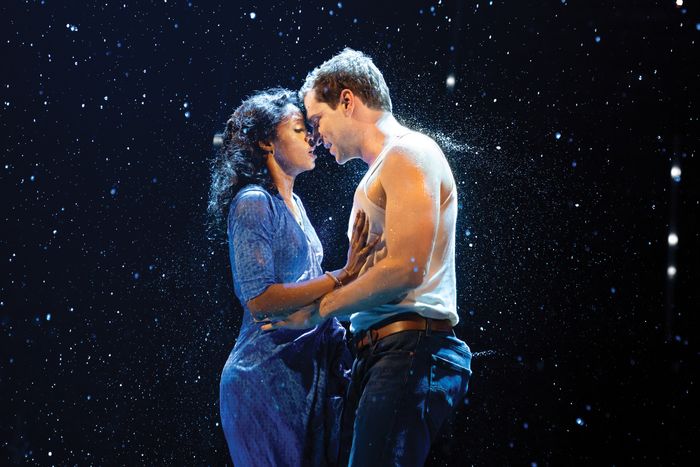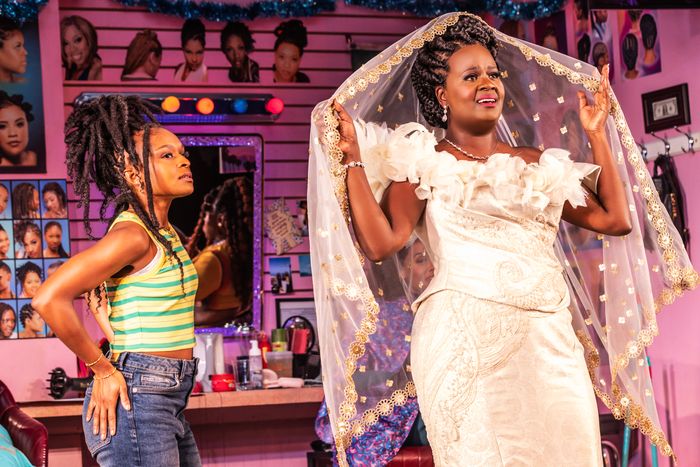Stereophonic.
Photo: Julieta Cervantes
This is the latest edition of The Critics, our weekly roundup of critical reviews, essays, and conversations from features writer Madeline Leung Coleman. Want to have it arrive in your inbox every Friday? Sign up here:
In a theater-loving town where it feels like a standing ovation is standard procedure, it’s time to find out which applause will go down in history — it’s awards season! This week, both the Drama Desk Awards and the Tonys dropped their nominees, with the Alicia Keys bio-musical Hell’s Kitchen and Fleetwood Mac–inspired Stereophonic leading the list for the latter — each of those shows has 13 nominations, while The Outsiders comes in close behind with 12. And while we could place bets on who will win Best Revival or Best Lead Actor in a Musical, there’s one thing the official awards will never be able to do: tell you what theater critics really talk about over postshow martinis.
That includes our very own Sara Holdren and Jackson McHenry. These two critics have spent the past few months cramming their schedules with previews and spinning out reviews of all the big shows (and a clutch of small ones too). Now that they’ve seen it all, they’re ready to hand out some honors of their own — in categories the Tonys voters never dreamed of. Welcome to our awards show. Go ahead and call it the Phonys.
With respect to Rachel McAdams’s nurturer in Mary Jane, this season belongs to the moms who can’t — or won’t! It’s a crowded field: Sarah Paulson in Appropriate, Jessica Lange in Mother Play, Cole Escola in Oh, Mary!, Shoshana Bean in Hell’s Kitchen, Kelli O’Hara in Days of Wine and Roses …
Jackson McHenry: I’m awarding this to Cole Escola’s Mary Todd Lincoln in Oh, Mary! for refusing to acknowledge her children at all.
Sara Holdren: I also vote for Escola, because I don’t think the existence of Mary Todd’s children bothers her whatsoever. In Appropriate, despite some of the real horrors of Paulson’s character, she still takes her teenager’s face in her hands and goes, “I love you.” She’s trying. Mary Todd wins points for not trying.
An epidemic has struck the stages of New York: The actors treading the boards are being forced to compete with over-the-top video projections meant to cheat in backgrounds and visual effects. The nominees include The Great Gatsby, Spamalot, and The Wiz.
Sara: I believe in The Great Gatsby for this category. The oversaturated digi-video element is so in your face and distracting — there are moments where you’re probably supposed to be paying attention to a character, and instead you’re like, “Oh, look, another mansion or a golf course or digital rain.” I realized something about the video sets in both Gatsby and The Wiz: Neither had an ensemble that was particularly small, but in each I felt like it wasn’t taking up enough space — the ensembles felt weirdly little and underpowered for the stage. But I think it’s actually because they’re being eaten by the backgrounds. Nothing is lifting up the human body. Everything is competing with it.
Jackson: Unfortunately, I think the set for The Wiz is even uglier than the one for Gatsby, especially the yellow brick road. If Gatsby’s set looks like a simulator, The Wiz’s looks like a video-game loading screen. You’re waiting for it to boot up so you can enter a level.
The Notebook.
Photo: Julieta Cervantes
A strong season for the elements, including both fire and pouring rain in shows such as The Notebook, The Outsiders, Uncle Vanya, Suffs, Teeth, and The Great Gatsby.
Sara: For most effective use of the elements, I’d say The Outsiders for that rumble in the rain, where they’re doing a prolonged piece of stage combat covered in mud. Also for whatever they’ve put on the stage — I think it’s cork or something like that, but it’s supposed to feel like dirt. There are these beautiful moments in the choreography where they kick it toward the audience, creating clouds.
Jackson: For the most elements, the rain in The Notebook. There’s a lot of wet.
Do we really need to see an actual vehicle right now? No, but it’s here anyway — in shows such as The Great Gatsby, The Outsiders, and Lempicka.
Jackson: This one goes to Lempicka, the bio-musical of Polish painter Tamara de Lempicka played by Eden Espinosa. (We just learned the show is closing May 19.) She paints a woman in a car, and then, suddenly, you see the car. Why? Who knows. It just rolls in and out. Some might say, “Well, what about Back to the Future?” The car in Back to the Future isn’t there for some reason — it is the reason that you came to see the show.
In not-great productions, these performers outshine their surroundings. Nothing but respect for the very brave John Zdrojeski in The Great Gatsby, Mia Katigbak in Uncle Vanya, and Quincy Tyler Bernstine in Doubt.
Jackson: I would give it to Mia Katigbak in Uncle Vanya because she’s just wonderful despite the show. I also think Quincy Tyler Bernstine is so good in Doubt, but that is also kind of the part where you’re supposed to get someone to come in and just kill that scene. I do think the way that she does it is really impressive because she doesn’t overplay it. She’s not doing the tears and snot.
Sara: John Zdrojeski as Tom Buchanan in Gatsby. While I love everything Katigbak does, she’s the kind of actor who really knows how to smooth the edges of things. You know what I mean? She can always fit herself into the world she’s acting in. But with Zdrojeski in Gatsby, I mean, he really does just feel like a different category of performer than the rest of the cast. The rest feel so, “Hello, everyone! Jazz hands!” And he’s like, “I’m here to play a psychologically complex role.”
A specific and delightful trend: shows set in the landlocked states that prominently feature dance. Nominees include The Outsiders (Tulsa), Illinoise (duh), The Heart of Rock and Roll (Chicago?), How to Dance in Ohio (duh), and Dead Outlaw (Oklahoma but eventually California).
Sara: Illinoise really is a show based entirely in the body. I was excited when I realized that it would not have a conventional book, that they weren’t going to be talking the whole time, and the choreographer Justin Peck does beautiful work. But the only reason I’m going with Illinoise instead of Dead Outlaw — a great show that was at the Minetta Lane Theatre until a couple weeks ago — is a technicality: Despite the fact that most of the story is based in and around Oklahoma, the one who does the wild, one-man Busby Berkeley dance I’m thinking of, Thom Sesma, is actually playing the L.A. County coroner.
Jackson: I still want to vote for Dead Outlaw — not only because of Sesma’s dance, but also because of the train heist and horseback riding. It’s got so much great movement and this kind of open-sky vastness.
For when part of your job is pretending to be high. Nominees: Stereophonic (cocaine), Lempicka (opiates, etc.), Tommy (acid)
Jackson: I mean, the Stereophonic coke bag. How can you not? It’s so big. The way that Sarah Pidgeon does this glamorous little sniff with her manicured nails really feels lived-in and of the era.
Who knew there would be more than one show featuring a screaming match between songwriters? The nominees: Merrily We Roll Along and Stereophonic.
Sara: Merrily is so wonderful, but I’m going to go with Stereophonic just because it’s about creative differences in their present frictional form. So many moments are fueled by active tension — whereas a lot of what we’re watching in Merrily is the consequences of that. In Stereophonic, there’s this moment where they play an incredible song and everyone is sitting in how incredible it was. Then Peter (Tom Pecinka) turns to his bandmate and girlfriend Diana (Sarah Pidgeon) and says, “It’s good, but there’s only so much I can do if you’re not gonna cut the verses down; your ego is getting in the way.”
Jackson: If we were just considering Daniel Radcliffe’s song about working with Jonathan Groff’s character in Merrily, “Franklin Shepard, Inc.,” I would give it to that.
And it’s not from the actor who is currently playing the Emcee in Cabaret.
Sara: The best current performance as this kind of character is not the one by Eddie Redmayne, who’s in Cabaret at the Kit Kat Club on Broadway — it’s George Abud as Marinetti in Lempicka. He’s playing an artist who was the real-life father of futurism, historically shoehorned into the play. But that doesn’t matter, because he does what the Emcee in Cabaret is supposed to do: He guides us along as the world tumbles toward fascism. The opinions he expresses are explicitly ugly, but Abud does it with so much successful charm without giving away any of the menacing. Whereas Redmayne’s Emcee is just a mess, wiggling his fingers.
Jackson: He totally tips his hand. It’s odd to watch Cabaret and never feel like you’re being seduced by the Emcee. Redmayne’s Emcee is just going, “Welcome to Berlin, it’s evil,” and hopping around. There is meant to be a complicated dynamic with the Emcee where he’s both sort of queer and luring you into fascism. But this production seems to tell you, “All of this expression is going to lead to being a brown shirt.” It seems un-thought-through and un-nuanced. Abud is much more convincing.
For the recent retiree in your life. Tommy, Stereophonic, The Heart of Rock and Roll.
Jackson: Stereophonic. A story based on Fleetwood Mac making Rumours is material for great drama. Whereas The Heart of Rock and Roll is, although kind of charming, inspired by the Huey Lewis and the News catalogue.
Sara: It may not be a full vote, but I will throw in a weird little thumbs-up for the Who musical, Tommy. It is undeniably dated, and yet there’s something that’s still exciting there. There’s something about both the Who’s music and Ali Louis Bourzgui’s central performance as Tommy that weirdly holds up.
Jackson and Sara agree: There’s no way that the very run-of-the-mill Alicia Keys musical Hell’s Kitchen should be nominated for as many Tonys as Stereophonic.
Photo: Matthew Murphy
The Tonys doesn’t usually hand out prizes for this — but then they surprised us by announcing a special award for Jaja’s hair and wig designer Nikiya Mathis. Let’s talk about her work!
Jackson: The play takes place at a hair-braiding salon over the course of a day, and the entire time you need to have convincing braiding going on — these women are meant to be very good at their jobs. There are even little skips in time, which means the actors’ wigs need to progress far enough forward to be realistic and to create the sense of work being done. The show managed to communicate so much about the characters and the setting just using the materials of hair itself.
Sara: It’s spectacular. The actress Kalyne Coleman, who played multiple customers in the show, posted this incredible video of one of her quick changes where she runs offstage, loses her whole costume and wig, gets another costume and wig, and goes back on as another character. Watching that happening on stage was incredible, but so was seeing what happened backstage.
A special award for the erstwhile eldest boy, whose starring role in An Enemy of the People involves getting a bucket of real ice dumped on top of him at every performance.
Sara: It’s clearly his favorite moment in the entire show.



